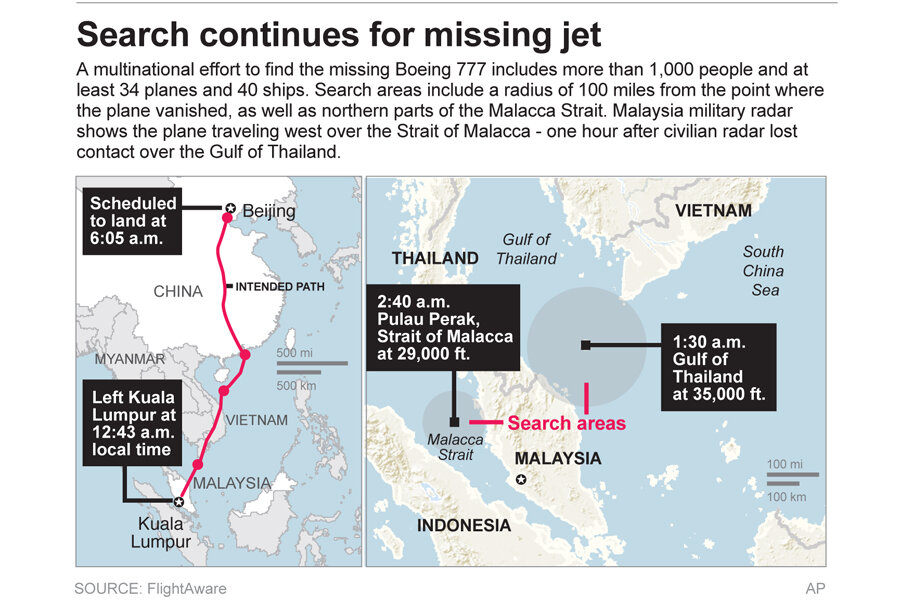Malaysia Airlines Flight 370: Why some pilots point to mechanical error
Loading...
| Kuala Lumpur, Malaysia
With few hard facts forthcoming about the disappearance of Malaysia Airlines flight MH370, speculation is rife. Was it hijacked and secretly landed at a remote central Asian airstrip? Did the pilots deliberately divert it for nefarious ends?
A more mundane possibility has received less attention: that the jet suffered from a malfunction and that its pilots were not villains, but heroes.
Investigations into the pilots' background have proven inconclusive. Nor have any links emerged between any passengers and known terrorist groups, according to the Malaysian police chief. And that absence of motive has led some aviation experts and pilots to suggest that the biggest mystery in modern aviation history may hinge on a problem with the plane itself.
The Boeing 777 is one of the safest airplanes in the world. “But there could have been an electrical fire,” suggests Chris Goodfellow, a former commercial and corporate jet pilot whose analysis, first posted on Google+, strike some aviation experts as plausible. “Dense smoke would not have taken long to overcome the pilots” even if they were wearing protective equipment, he said in a telephone interview.
Even without anyone at the controls, the plane would have continued to fly on its own until it ran out of fuel whether or not it was on auto-pilot, according to aviation experts. “That plane would have been able to run pretty much on its own,” says Ron Bishop, a former US Air Force flight engineer.
“If the engines are set to a setting they will keep going, and as long as wings get air across them they will keep aloft…steady, straight and level” with minor changes in altitude, he adds.
Mr. Goodfellow argues that the pilots changed direction in search of an airport because of an onboard crisis. That theory “is very plausible,” says Prof. Jason Middleton, head of the school of aviation at the University of New South Wales in Sydney, Australia. “It makes sense.”
He cautions, though, that there is no proof. “All the theories have some problem with them and they are all improbable,” Prof. Middleton says.
Rerouting toward a nearby airport?
Faced with “an immediate crisis” on board, the pilots would have diverted to the nearest suitable airport, says Goodfellow. One option was Langkawi Island, off Malaysia’s west coast, where a 13,000 feet long runway is approached over the sea. After veering off its flight path and turning west, the plane was headed towards Langkawi.
If the pilots were trying to land there, they did not succeed, perhaps because they had already been overcome by smoke in the event of a plane malfunction.
Malaysia says its military radar tracked an object that appeared to be the plane following a traditional navigational route, meaning that it was being deliberately flown. But Goodfellow questions whether the quickly fading radar blips actually came from a Madrid-bound Singapore Airlines commercial jet that was in the immediate vicinity at the time.
“That is certainly possible,” says Middleton. “The information flow [about the military radar data] has been extraordinarily confused and ambiguous.”
'Aviate, navigate, communicate'
There has also been confusion about the exact sequence of events when the Beijing-bound plane changed course.
Investigators do not know whether the plane’s ACARS tracking system was turned off, or ceased to function, before or after the last conversation with the cockpit, nor whether it happened before or after the transponder went dead.
A fire could have disabled the tracking and communications systems without any intentional action by a pilot or hijacker. That may explain the abrupt shutdown. To turn ACARS off, someone must descend through a hatch in full view of the cabin staff.
Former pilots suggest that Capt. Zaharie Ahmad Shah or his co-pilot might have deliberately turned the transponder off – which is possible from the cockpit – if they had detected an electrical fire. The standard operating procedure in case of such a fire is to turn off all the circuit breakers and then restore them one by one until the problem has been isolated.
The lack of a distress signal puzzles Goodfellow, but the routine in emergencies, he points out, is “aviate, navigate, communicate” and the pilots may not have had time to communicate.
They may have tried to do so. Kuala Lumpur air traffic controllers, however, had turned the plane over to their Vietnamese counterparts and might no longer have been listening to its communications as it entered a "no-mans land" between the two. The pilots are not thought to have made voice contact with Ho Chi Minh airport before the plane changed course.
Autopilot route
If the pilots were overcome by smoke, or by lack of oxygen, the 777 would have continued to fly along its last course setting, says Bishop, the former USAF flight engineer who worked on Hercules C-130s.
“If there is no pressure on the flight controls, if the plane is trimmed to fly steadily, it will fly steady” at about 1,000 kilometers per hour until it runs out of fuel, he says.
Such an event would not be unprecedented. In 1999 the US golfer Payne Stewart died when his Learjet crashed nearly four hours after the pilot and passengers apparently passed out for lack of oxygen when cabin pressure fell drastically.
“My first bet would be a malfunction such as a fire in the communications bay,” says Middleton. "But everyone is playing amateur detective at the moment and there is not enough positive data. We just don’t know."









